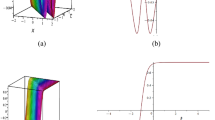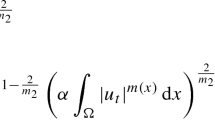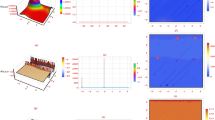Abstract
The generalized modified Equal–Width (GMEW) equation is often used to show how a one-dimensional wave moves through a medium that is not linear and has dispersion processes. In this article, we’ll use two very precise, cutting-edge analytical and numerical methods to find the exact traveling wave solutions for the model we’re looking at. These discoveries are really new, and they could immediately change how people train in engineering and physics. Now that a numerical approach has been described, we can roughly evaluate the replies’ accuracy. Analytical and quantitative data were shown using contour plots and two- and three-dimensional graphs. Our method of symbolic computing shows that it has the potential to be a powerful mathematical tool. It can be used to solve a wide range of nonlinear wave problems. Our findings are the outcome of our topic investigation.
Similar content being viewed by others
Avoid common mistakes on your manuscript.
1 Introduction
Nonlinear optics studies how light behaves in materials with nonlinear optical properties. It looks at how a one–dimensional wave moves through a nonlinear medium with dispersion [1]. When discussing electromagnetic waves in a waveguide or acoustic waves in a pipe, the phrase “one–dimensional wave” indicates the waves’ restricted capacity to move in more than one dimension [2].
Nonlinear media have optical properties that depend on how strongly the electromagnetic field goes into the material. In other words, the behavior of the wave is no longer proportional to the incoming information, and nonlinear impacts may become significant [3]. Still, dispersion processes explain why the refractive index of a material changes when an electromagnetic wave passes through it. This suggests the wave disperses because its different frequencies move at varying speeds [4].
When modeling how a one–dimensional wave moves through a nonlinear medium with dispersion, it is essential to consider how these two things work together. In particular, nonlinearities can make the wave grow as it moves, leading to soliton propagation when it keeps its original shape and intensity over long distances [5]. Pulse widening happens when the wave’s temporal profile gets longer because of dispersion, which occurs when the wave’s frequency spreads out [6].
These effects may be examined using mathematical models such as the nonlinear Schrödinger equation and GMEW equation, which describes the evolution of the wave envelope during propagation [7]. The behavior of the wave may be anticipated by numerically solving this equation, which accounts for dispersion and nonlinearities. One–dimensional wave propagation in nonlinear media with dispersion processes could be helpful in a number of fields, such as laser physics, photonics, and telecommunications [8]. In order to build devices and systems that exploit nonlinearities and dispersion to achieve specific goals, such as long–distance information transmission or the creation of ultrashort laser pulses, it is necessary to comprehend the interplay between these two phenomena [9].
In this context, this paper studies the GMEW equation that is a flexible and cutting–edge method for evaluating and classifying data [10]. This new method is based on Equal–Width (EW) discretization, often used to prepare data and design features [11]. When discretizing continuous data, the GMEW equation is more flexible and easy to use than the EW method. It was created in part to remedy deficiencies in the EW method. This article is an introduction to the GMEW equation [12]. Its purpose is to teach the reader about its history, key ideas, and possible uses. The GMEW equation is given by [13,14,15]
where \(\mathcal {E}=\mathcal {E}(x,t)\) describes wave propagation in a nonlinear medium with dispersion processes in one dimension. While \(c_{1},\, c_{2},\, \varrho \) are arbitrary constants. There are a variety of computational methods that may be utilized to solve the GMEW equation numerically. Some examples are as follows [16,17,18]:
-
Bulet Finite difference methods are often used to solve partial differential equations quantitatively. Using grid discretization and finite difference approximation, the GMEW equation derivatives are estimated.
-
Bulet Fourier spectral approaches add the sine and cosine functions as a scalar. The GMEW equation is Fourierized with this method. Runge–Kutta and split-step Fourier techniques may be helpful.
-
Bulet Adomian decomposition solves nonlinear differential equations by series extension. The linear differential equations of the GMEW equation are amenable to iterative numerical solutions. The answer is determined using series expansion.
These are some computer–based approaches to solving the GMEW equation [19, 20]. The problem, the available computing power, and how quickly and accurately you need to solve it all influence your chosen strategy [21,22,23,24,25,26,27,28,29,30,31,32,33,34,35,36,37]. Now, we are going to use the extended Khater method to find some novel solitary wave solutions of (1). Employing the next wave transformation \(\mathcal {E}=\mathcal {E}(x,t)=\upsilon (\eta ),\, \eta =\lambda \,t+x\), to Eq. (1), gets
Balancing the nonlinear term and highest order derivative term in (2) along with the extended Khater method’s auxiliary equation \(f''(\eta )= \frac{1}{\log (K)} \left( -\alpha ^{2} \,K^{-2 \,f(\eta )}-\alpha \,\beta \, K^{-f(\eta )}+\right. \) \(\left. \beta \,\gamma \,K^{f(\eta )}+\gamma ^{2} \,K^{2 \,f(\eta )}\right) \), where \(\alpha , \,\beta , \, \gamma \) are arbitrary constants, yields necessary of using another transformation that is given by \(\upsilon =\varphi (\eta )^{2/\varrho }\). The new transformation converts (2) into the following ODE
Using the homogeneous balance principles to (3) and along with the extended Khater method’s headlines, gets the
where \(a_{0},\, a_{1}\) are arbitrary constants.
In our paper, we investigate some new solitary wave solutions of the model under study, and in Sect. 2, we talk about how accurate they are. A graphical representation of the solutions can be found in Sect. 3. The comprehensive study’s conclusion is presented in Sect. 4.
2 Stable Solitary Wave and Approximate Solutions
In this section, we examine the computational solutions of the GMEW equation with the extended Khater method [38, 39] as well as the variational iteration \((\mathcal {VIM})\) method [40, 41].
2.1 Stable Soliton Wave Solution
Employing the extended Khater method to (3) along with Eq. (4), gets the following values of the above–mentioned parameters
Set I
Set II
Set III
Backing these values into Eq. (4) along with the solution of the extended Khater method’s auxiliary equation’ s solutions, leads to the following solitary wave solutions of the investigated model.
For \(\beta ^{2}-4 \,\alpha \,\gamma <0\), we get
While, for \(\beta ^{2}-4 \,\alpha \,\gamma >0\), we get
2.1.1 Solution’s Stability
Now, we are using the Hamiltonian system’s characterizations to figure out the stability property of the above–constructed solutions [42]. Firstly, we construct the momentum of Eq. (13)
Thus, the stability condition is given by
Consequently, (13) is table solution on the following interval \(x \in [-5,5],\, t \in [-5,5].\) Using same technique, checks the stability property of the other solutions Fig. 1.
Representation for the momentum of (13) in two-dimensional graph
2.2 Numerical solutions
Applying the \(\mathcal {VIM}\) to (1) with some specific values for the above–mentioned parameters in (13), yields
3 Solutions’ Graphical Representation
The GMEW equation is an extension of the conventional EW method that contains a modification factor to produce bins of variable lengths. The distribution of the data may reveal areas with varying densities, which is the typical method for determining this variable. The modification factor modifies the widths of the produced bins to better match the data’s local attributes.
The GMEW equation may be used for several data analysis applications, like:
-
Discreteizing continuous data into more manageable intervals during the preprocessing stage is one way for decreasing computer demands and facilitating subsequent analysis.
-
GMEW equation may be used to generate new features depending on the distribution of the underlying data, hence possibly enhancing the performance of machine learning algorithms.
-
The third use is clustering and classification, where discretized data may be utilized as input for clustering algorithms and classification tasks, enabling the discovery of previously unknown patterns and correlations.
In conclusion, the GMEW equation is a cutting-edge data discretization methodology that gives more flexibility and adaptability than conventional equal–width techniques. By taking into consideration the underlying data distribution and modifying bin widths appropriately, the GMEW equation may improve the efficiency of data analysis and machine learning by providing more accurate and relevant representations of continuous data.
Here, we decompose the discovered computational solutions into their component polar, density, 3-D, and 2-D graphs. We expand on the built-in solutions described before ( (11), (13), (15), (21)) when \( \Bigg {[} \alpha =2,\,a_{1}=-1,\,\beta =3,\,\gamma =1,\,\lambda =4,\,\mho =5\, \& \, \alpha =3,\,a_{1}=-2,\,\beta =5,\,\gamma =2,\,\lambda =10,\,\mho =20\, \& \, \alpha =6,\,a_{1}=3,\,\beta =5,\,\gamma =1,\,\lambda =2,\,\mho =-1 \Bigg {]}\).In these graphs, (11), (13) and (15) show bright–dark soliton waves, and (21) shows periodic waves Figs. 2, 3, and 4. Also, the matching between analytical and numerical solutions are illustrated by Fig. 5 and Table 1. Specifically, we have demonstrated the interaction between the above-analytical and numerical solutions by displaying examples in Figs. 6, and 7 examples concern wave propagation in nonlinear materials with dispersive processes Fig. 8.
Graphically displays of (11) in (a) 3D, (b) 2D, (c) contour and (d) polar plots
Graphically displays of (13) in (a) 3D, (b) 2D, (c) contour and (d) polar plots
Graphically displays of (15) in (a) 3D, (b) 2D, (c) contour and (d) polar plots
Graphically displays of Eq. (21) in (a) 3D, (b) 2D, (c) contour and (d) polar plots
4 Conclusion
Throughout the course of this study, soliton wave solutions for the GMEW model were generated utilizing a variety of equations. There were rational, hyperbolic, and trigonometric equations among them. These connections give more information about how waves move through nonlinear media. We could ensure success by using the mathematical \(\mathcal {VIM}\) to double-check our calculations. These lessons have been broken down and simplified using various visual aids. We decided if the study was new and vital by comparing its results to those of other studies that had found similar things. Each result was checked in Mathematica 13.1 before being re-implemented in the primary model.
Data Availability
The data that support the findings of this study are available from the corresponding author upon reasonable request.
References
Khater, M.M.: A hybrid analytical and numerical analysis of ultra-short pulse phase shifts. Chaos, Solitons & Fractals 169, 113232 (2023)
Khater, M.M., Zhang, X., Attia, R.A.: Accurate computational simulations of perturbed chen-lee-liu equation. Results Phys. 45, 106227 (2023)
Khater, M.M., Alfalqi, S.H., Alzaidi, J.F., Attia, R.A.: Analytically and numerically, dispersive, weakly nonlinear wave packets are presented in a quasi-monochromatic medium. Results Phys. 46, 106312 (2023)
Khater, M.M. Computational and numerical wave solutions of the caudrey–dodd–gibbon equation. Heliyon 9(2)
Khater, M.M., S. H. Alfalqi, J. F. Alzaidi, R. A. Attia, Novel soliton wave solutions of a special model of the nonlinear schrödinger equations with mixed derivatives. Results Phys. 106367 (2023)
Khater, M.M.: Multi-vector with nonlocal and non-singular kernel ultrashort optical solitons pulses waves in birefringent fibers. Chaos, Solitons & Fractals 167, 113098 (2023)
Khater, M.M. Physics of crystal lattices and plasma; analytical and numerical simulations of the gilson–pickering equation, Results Phys. 106193 (2023)
Khater, M.M.: Hybrid accurate simulations for constructing some novel analytical and numerical solutions of 3-order gnls equation. Int. J. Geom. Methods Mod. Phys. 2350159 (2023)
Khater, M.M., Attia, R.A., Lu, D.: Explicit lump solitary wave of certain interesting (3+ 1)-dimensional waves in physics via some recent traveling wave methods. Entropy 21(4), 397 (2019)
Khater, M.M., Attia, R.A., Lu, D.: Modified auxiliary equation method versus three nonlinear fractional biological models in present explicit wave solutions. Math. Comput. Appl. 24(1), 1 (2018)
Abdel-Aty, A.-H., Khater, M.M., Baleanu, D., Abo-Dahab, S., Bouslimi, J., Omri, M.: Oblique explicit wave solutions of the fractional biological population (bp) and equal width (ew) models. Adv. Differ. Equ. 2020, 1–17 (2020)
Ali, U., Mastoi, S., Mior Othman, W.A., Khater, M., Sohail, M.: Computation of traveling wave solution for nonlinear variable-order fractional model of modified equal width equation. Aims Math. 6(9), 10055–10069 (2021)
Khater, M.M.: Nonlinear biological population model; computational and numerical investigations. Chaos, Solitons & Fractals 162, 112388 (2022)
Khater, M.M.: In surface tension; gravity-capillary, magneto-acoustic, and shallow water waves’ propagation. Eur. Phys. J. Plus 138(4), 320 (2023)
GaziKarakoc, S.B., Ali, K.K.: Analytical and computational approaches on solitary wave solutions of the generalized equal width equation. Appl. Math. Comput. 371, 124933 (2020)
Evans, D.J., Raslan, K.: Solitary waves for the generalized equal width (gew) equation. Int. J. Comput. Math. 82(4), 445–455 (2005)
Adem, K.R., Khalique, C.M.: Exact solutions and conservation laws of zakharov-kuznetsov modified equal width equation with power law nonlinearity. Nonlinear Anal. Real World Appl. 13(4), 1692–1702 (2012)
Saha, A.: Bifurcation, periodic and chaotic motions of the modified equal width-burgers (mew-burgers) equation with external periodic perturbation. Nonlinear Dyn. 87(4), 2193–2201 (2017)
Karakoc, S.B.G., Omrani, K., Sucu, D.: Numerical investigations of shallow water waves via generalized equal width (gew) equation. Appl. Numer. Math. 162, 249–264 (2021)
Oruç, Ö.: Delta-shaped basis functions-pseudospectral method for numerical investigation of nonlinear generalized equal width equation in shallow water waves. Wave Motion 101, 102687 (2021)
Khater, M.M.: Diverse solitary and jacobian solutions in a continually laminated fluid with respect to shear flows through the ostrovsky equation. Mod. Phys. Lett. B 35(13), 2150220 (2021)
Khater, M.M.: Abundant breather and semi-analytical investigation: on high-frequency waves’ dynamics in the relaxation medium. Mod. Phys. Lett. B 35(22), 2150372 (2021)
Khater, M.M., Attia, R.A., Park, C., Lu, D.: On the numerical investigation of the interaction in plasma between (high & low) frequency of (langmuir & ion-acoustic) waves. Results Phys. 18, 103317 (2020)
Khater, M.M., Lu, D.: Analytical versus numerical solutions of the nonlinear fractional time-space telegraph equation. Mod. Phys. Lett. B 35(19), 2150324 (2021)
Khater, M.M.: Nonparaxial pulse propagation in a planar waveguide with kerr-like and quintic nonlinearities; computational simulations. Chaos, Solitons & Fractals 157, 111970 (2022)
Khater, M.M.A.: In solid physics equations, accurate and novel soliton wave structures for heating a single crystal of sodium fluoride. Int. J. Mod. Phys. B 37(7), 2350068–139 (2023)
Khater, M.M.A.: Nonlinear elastic circular rod with lateral inertia and finite radius: dynamical attributive of longitudinal oscillation. Int. J. Mod. Phys. B 37(6), 2350052 (2023)
Yue, C., Higazy, M., Khater, O.M.A., Khater, M.M.A.: Computational and numerical simulations of the wave propagation in nonlinear media with dispersion processes. AIP Adv. 13(3), 035232 (2023)
Khater, M.M.A., Alzaidi, J.F., Hussain, A.K. Abundant solitary and semi-analytical wave solutions of nonlinear shallow water wave regime model. In: American Institute of Physics Conference Series, vol. 2414 of American Institute of Physics Conference Series, p. 040098 (2023)
Attia, R.A.M., Zhang, X., Khater, M.M.A.: Analytical and hybrid numerical simulations for the (2+1)-dimensional Heisenberg ferromagnetic spin chain. Results Phys. 43, 106045 (2022)
Khater, M.M.A., Botmart, T.: Unidirectional shallow water wave model; Computational simulations. Results Phys. 42, 106010 (2022)
Khater, M.M.A.: Analytical and numerical-simulation studies on a combined mKdV-KdV system in the plasma and solid physics. Eur. Phys. J. Plus 137(9), 1078 (2022)
Jiang, Y., Wang, F., Salama, S.A., Botmart, T., Khater, M.M.A.: Computational investigation on a nonlinear dispersion model with the weak non-local nonlinearity in quantum mechanics. Results Phys. 38, 105583 (2022)
Zhao, D., Lu, D., Khater, M.M.A.: Ultra-short pulses generation’s precise influence on the light transmission in optical fibers. Results Phys. 37, 105411 (2022)
Khater, M.M.A.: Lax representation and bi-Hamiltonian structure of nonlinear Qiao model. Mod. Phys. Lett. B 36(7), 2150614 (2022)
Khater, M.M.A., Lu, D.: Diverse Soliton wave solutions of for the nonlinear potential Kadomtsev-Petviashvili and Calogero-Degasperis equations. Results Phys. 33, 105116 (2022)
Zhao, D., Attia, R.A.M., Tian, J., Salama, S.A., Lu, D., Khater, M.M.A.: Abundant accurate analytical and semi-analytical solutions of the positive Gardner-Kadomtsev-Petviashvili equation. Open Phys. 20(1), 1 (2022)
Khater, M..M.. De.: broglie waves and nuclear element interaction; abundant waves structures of the nonlinear fractional phi-four equation. Chaos, Solitons & Fractals 163, 112549 (2022)
Khater, M.M.: Recent electronic communications; optical quasi-monochromatic soliton waves in fiber medium of the perturbed fokas-lenells equation. Opt. Quant. Electron. 54(9), 586 (2022)
Khater, M.M.: Abundant breather and semi-analytical investigation: on high-frequency waves’ dynamics in the relaxation medium. Mod. Phys. Lett. B 35(22), 2150372 (2021)
Khater, M.M. Prorogation of waves in shallow water through unidirectional dullin–gottwald–holm model; computational simulations. Int. J. Mod. Phys. B 2350071 (2022)
Khater, M.M. Abundant stable and accurate solutions of the three-dimensional magnetized electron-positron plasma equations. J. Ocean Eng. Sci
Acknowledgements
The researchers would like to a knowledge Deanship of Scientific Research, Taif university for funding this work.
Funding
This research has not received any fund from anywhere.
Author information
Authors and Affiliations
Contributions
All the study has been done by the author himself.
Corresponding author
Ethics declarations
Ethics approval and consent to participate
Not applicable.
Consent for publication
Not applicable.
Conflict of interest
The authors declare that they have no competing interests.
Additional information
Publisher's Note
Springer Nature remains neutral with regard to jurisdictional claims in published maps and institutional affiliations.
Rights and permissions
Springer Nature or its licensor (e.g. a society or other partner) holds exclusive rights to this article under a publishing agreement with the author(s) or other rightsholder(s); author self-archiving of the accepted manuscript version of this article is solely governed by the terms of such publishing agreement and applicable law.
About this article
Cite this article
Khater, M.M.A. Numerous Accurate and Stable Solitary Wave Solutions to the Generalized Modified Equal–Width Equation. Int J Theor Phys 62, 151 (2023). https://doi.org/10.1007/s10773-023-05362-4
Received:
Accepted:
Published:
DOI: https://doi.org/10.1007/s10773-023-05362-4












